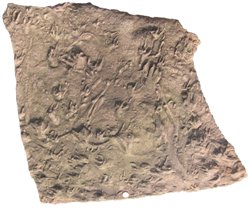
Since Carroll’s groundbreaking work, abundant vertebrate fossils have continued to drop out of the Joggins cliffs (now a UNESCO World Heritage Site). However, this amazing fossil assemblage poses as many questions as it answers. For example, we now know that both major lineages of reptiles – synapsids and sauropsids - occur in the Early Pennsylvanian Joggins Formation. This implies that reptiles had already existed for some time before Hylonomus fatefully crawled into that hollow tree-stump, 315 million years ago. Unfortunately, the fossil record is silent about this earlier phase of reptile evolution. In fact we have to travel back a further 15-20 million years before another diverse vertebrate fossil site is encountered: the famous late Viséan locality at East Kirkton, Scotland. However, despite various false alarms, no true reptiles have yet been found at this deeper stratigraphic level.
With fossil bones and teeth so rare, how can palaeontologists shed light on the evolutionary events that led up to the appearance of reptiles? One approach is to study the footprints they left behind. Tracks are far more abundant than bone. Furthermore they tell us much about the ecology of the animals that made them. As luck would have it tracks are very common in the Carboniferous rocks of the Bay of Fundy. William Logan, the early Canadian geologist, first spotted tracks in Tournaisian rocks at Horton Bluffs, Nova Scotia, in 1841, and since then there has been a torrent of discoveries through the entire Carboniferous succession. New fossils are constantly falling from the coastal cliffs of this part of eastern Canada, hewn by the legendary power of the Fundy tides – the world’s highest.